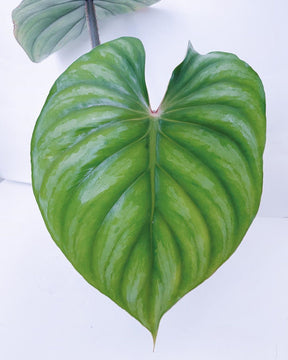The Simple Guide to Philodendron Gloriosum Care
 Some of the links in this post may be affiliate links.
Some of the links in this post may be affiliate links.
With its distinctive veins and oversized, heart-shaped leaves, Philodendron Gloriosum is a foliage plant that’s simply striking to look at.
Let’s get right into the facts and care of this stunning plant!
- Philodendron Gloriosum is a creeper plant – it grows by crawling along the ground and sends up leaf stems.
- The plant’s origin is Colombia, but it’s also native to countries such as Central America, Mexico, Brazil and Venezuela.
- A mature Gloriosum produces white flowers around every May to July.
- P. gloriosum has crossed with P. Melanochrysum to produce a beautiful hybrid: Philodendron Glorious (read more at the end!)
Philodendron Gloriosum Care Requirements
Light
Bright indirect sunlight (70-85%) is the best for Gloriosum to grow large, beautifully veined leaves. Do not directly expose your plant to the sun. The consequence? Ughh … leaf burn.
Temperature
Temperatures should be between 65°-80°F. During winter, bring the plant indoors to avoid frost. Your grow light should have a 24’’ (61cm) distance from the leaves to – again – prevent leaf burn.
Humidity
You can mist your Gloriosum with a spray bottle to increase humidity (at least temporarily). Imagine a moisturizing face spa for those velvety leaves! Ahhh. To increase the humidity for longer periods, make use of an indoor humidifier.
Watering
Stick your finger into the pot. Is the half topsoil dry? If yes, you can water it. A watering schedule of 1-2 times a week should do the trick.
Never overwater. Your Gloriosum would thank you with its rot-free roots.
Soil
Provide well-draining, moist soil with high organic matter. Some recommendations:
- 100% sphagnum peat moss
- An orchid potting mix - add in peat and perlite to allow better aeration.
The ideal soil acidity is 6.5-7.5.
- Add horticultural charcoal to imitate the natural “forest” environment of the plant. Charcoal also helps guard against bacteria and fungus by sweetening the soil and drawing out toxins.
- If the soil is too soggy (poor drainage), try using a soil mix of perlite, pumice and/or orchid bark.
- For a raw cutting, you can use cinnamon as a disinfectant to help the “wound” to heal.
Potting
We recommend a long, rectangular pot with drainage holes.
Why not a round one? As a creeper, Gloriosum will soon reach the pot’s edge. You’ll need to do repotting way more times than necessary.
Repotting
When it’s over the edge, the plant can’t grow roots into the soil anymore. The leaves are likely to become smaller, too. Time to repot!
Fertilizing
Fertilize your Gloriosum during the spring months to fall, once every month. Try a balanced liquid fertilizer with a 20-20-20 NPK formulation. We prefer Jack's Classic All Purpose 20-20-20. Keep in mind to dilute the fertilizer by half the recommended amount.
Growth & Size
Philodendron Gloriosum is a rather slow grower. A leaf spike to a full opening may take 1-2 months.
And nope, overenthusiastic watering or fertilizing will not speed up the process. Remember the root rot headache?
Be patient - the plant can reach a height of 90 cm!
Pruning
Remove yellow, old and dead leaves. You can also prune your Gloriosum if it’s taking up too much space. Cut at the stem’s base and water the plant afterwards to minimize stress. We like to use these pruning shears.
Propagation by Stem Cutting: 5 Steps
- Find a long, healthy stem (3-6’’ long) with leaves and roots.
- Cut the stem at the joint that meets the main crown.
- Place the cut stem in your prepared pot of soil.
- Water and place in indirect sunlight.
- Voilà – your new Gloriosum!
Dealing with Pests
Philodendron Gloriosum may be infested by the usual aphids, mealybugs and fungus.
Ditch the chemical insecticides that pollute your precious soil mixture. Go natural and use neem oil, such as this one from Captain Jack's. Spray diluted neem oil on your plant every two weeks.
Alternatively, you can boil neem leaves to produce your own fresh neem solution!
Common Problems
- Yellow leaves – Likely caused by direct sunlight exposure. Move your Gloriosum to a shady area.
- Droopy leaves – A sign of over- or under-watering. Make sure to check the soil before watering.
- Root rot – A common problem of overwatering. Fix a watering schedule and always test soil dampness before watering.
As a hybrid between P. melanochrysum and P. gloriosum, think of P. glorious as an indirect offspring of the Gloriosum! They have 3 main differences:
- Gloriosum is terrestrial, Glorious can be climbers.
- Gloriosum leaves are shorter, wider and lighter in color. Glorious leaves are darker due to characteristics gained from Melanochrysum.
- Glorious has an oval petiole, while for Gloriosum, it’s D-shaped and flat on top.
The smooth, glossy-green leaves of Philodendron Gloriosum add a wonderful tropical accent to any home. It’s definitely a worthwhile addition to your cozy plant collection.
Written byDenise Lim

















